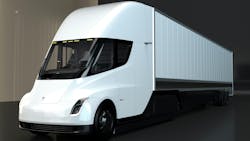Where regulators' push for heavy-duty EVs falls short
More emissions regulations coverage:
The latest federal greenhouse gas emissions standards for heavy-duty vehicles put significant pressure on manufacturers to sell electric vehicles. The technology still falls short of long-haul trucking needs.
EPA’s Greenhouse Gas Emissions Standards for Heavy-Duty Vehicles-Phase 3 stops short of an electric truck sales mandate, but the rule’s authors assume “most if not all” manufacturers will use EVs in their compliance strategies.
The broad regulatory push for ZEV adoption, both from regulations like GHG3 and institutions like the California Air Resources Board, received much criticism from the trucking industry. The American Trucking Associations, Owner-Operator Independent Drivers Association, and Automotive Dealers Association are just a few major industry organizations that have spoken out against the latest GHG standards.
See also: Trucking industry reacts to GHG3 rule pushing zero-emission adoption
There are three major ZEV criticisms that most people in trucking will point to: lack of charging infrastructure, limited range, and increased equipment costs.
Charging infrastructure is still behind
EV charging infrastructure for heavy-duty vehicles, especially DC fast-charging availability, is still very limited. Diesel fueling stations, meanwhile, are fairly ubiquitous.
While a similar problem existed in combustion fuel’s first days, it still presents a major hurdle for ZEV adoption.
EPA recognized this issue in the final rule. The agency says it will monitor heavy-duty ZEV infrastructure, issuing periodic reports on the market conditions that allow for GHG3 compliance with its standards. If the infrastructure for heavy-duty ZEVs falls short of EPA’s expectations, the agency would likely pursue a new rulemaking to adjust GHG3’s requirements.
A government agency’s promise to effectively change the rules if infrastructure development fails to pan out doesn’t inspire confidence. But charging stations continue to crop up along the U.S., likely to someday connect the major continental freight corridors.
See also: Panel: Despite challenges, heavy-duty EVs are improving
EVs still have a short range
For Class 8 tractors, the range of ZEVs doesn’t compete with traditional diesel combustion. Battery EVs and fuel cell EVs both have a fraction of the range of a conventional diesel vehicle. Long-haul trucking needs more range than ZEVs offer to remain efficient.
A heavy-duty diesel tractor often has a fuel capacity ranging from 120 to 300 gallons, depending on fuel tank size and configuration. An average heavy-duty tractor’s fuel economy is between 4.51 mpg and 6.47 mpg, according to Geotab’s State of Fuel Economy in Trucking. The North American Council for Freight Efficiency saw fuel economies rise to as much as 10, 12.5, or even 13 mpg in Run on Less 2017.
With that in mind, diesel vehicles can operate with a range of, on the low end, 541 miles—and, on the high end, as much as 3,000 miles. The median diesel range is likely closer to 1,000 miles.
Today, the high-end range of a Class 8 EV is 500 miles under a maximum payload, as boasted by Tesla. For hydrogen fuel cell vehicles (and most BEVs outside Tesla), most models' high-end range is lower, roughly 250 miles. According to SAE International, a H2-FC truck concept by Honda had an estimated maximum range near 400 miles. In its final rule, EPA noted that it had contracted FEV Group to analyze H2-FC range and the company found ways to deliver a 500-mile range with a hydrogen sleeper cab.
For its final rule, EPA has later standards for sleeper cabs, which kick in for MY 2030. The later standards for long-haul vehicles may give EV development time for further range improvements.
“What we would say would be achievable with zero-emission vehicles by 2030 in a sleeper is still not near what [the EPA] would say is achievable,” Lydia Vieth, research analyst of electrification and autonomy for ACT Research, told FleetOwner. “They try to lend a hand by pushing out the start date a little bit, but they are assuming that—whether it’s a BEV or fuel cell—it would be achievable by then.”
Range isn’t the only problem for EV powertrains’ hauling efficiency—charging speed also limits their ability to haul loads.
“To fill up a diesel truck, it’s going to take you 15 or 20 minutes,” Greer Woodruff, SVP of safety, sustainability, and maintenance for J.B. Hunt, said at the FTR Transportation Intelligence Conference in Indianapolis this September. “Hydrogen is at parity with diesel ... 15 or 20 minutes. But on a battery electric vehicle, best case, it’s going to take an hour. More likely, it’s going to take two or three hours. So, in the best case, it’s going to take you four times as long to energize the vehicle as with diesel.”
The Tesla Semi boasts a 70% charging speed of only 30 minutes, but this utilizes the manufacturer’s less common high-speed North American Charging Standard.
However, battery technology is improving drastically.
Similar to solar panels and HDTVs, the technology is getting more sophisticated at a rapid rate. Many in the trucking space assume that battery technology will eventually boast a range that can fit within long-haul operations.
“Maybe the technology will be there by then. We’ve got a lot of faith in battery technology improvements in the next decade,” Vieth said. “It’s not necessarily the tech being the issue, but it’s that cost. These vehicles are significantly more expensive.”
ZEVs are still more expensive
The costs of research, development, and rare metals for advanced technologies make EVs a costly choice for fleets.
According to Ryder’s 2024 analysis of the cost of EV conversions, without government incentives, the annual total cost for a fleet to convert from ICE to electric vehicles could be nearly double.
On the other hand, government incentives do help alleviate the price pain point for customer fleets—at least partially. One significant financial incentive is a tax credit from the Internal Revenue Service, which offers up to $40,000 for heavy-duty vehicles until 2032.
“Even if you get the full $40,000, that’s not closing that gap enough for folks to say ‘this is worth my much larger upfront cost,’” Vieth said.
The Bipartisan Infrastructure Law and Inflation Reduction Act made significant investments in electrification, including funding opportunities for fleets. The Electrification Coalition provides a helpful breakdown of electric freight funding streams.
Non-federal incentives can also bring down the upfront cost of EVs for fleets with geographic luck. For example, New York State has a voucher system that can cover up to 95% of an electric truck’s incremental cost.
However, these incentives can only apply to a small number of fleets—and are not guaranteed to last.
“That might get you to 2032, but greenhouse gas phase three doesn’t go away in ‘33, ‘34,” Rundle added.
No requirements for fleets to electrify
EPA’s ABT credit system incentivizes manufacturers to make and sell EVs, but there is no national version of something like CARB’s Advanced Clean Fleets to incentivize fleets to buy EVs. A tax credit to compensate for part of the price difference is a start but not quite a solution.
“And now the question is, how do you get your customers to buy that mix so you can be compliant? And I think that’s the hardest thing,” Rundle said. “It isn’t easy at all to price them, make a profit, and get individuals to purchase them.”
About the Author
Jeremy Wolfe
Editor
Editor Jeremy Wolfe joined the FleetOwner team in February 2024. He graduated from the University of Wisconsin-Stevens Point with majors in English and Philosophy. He previously served as Editor for Endeavor Business Media's Water Group publications.

